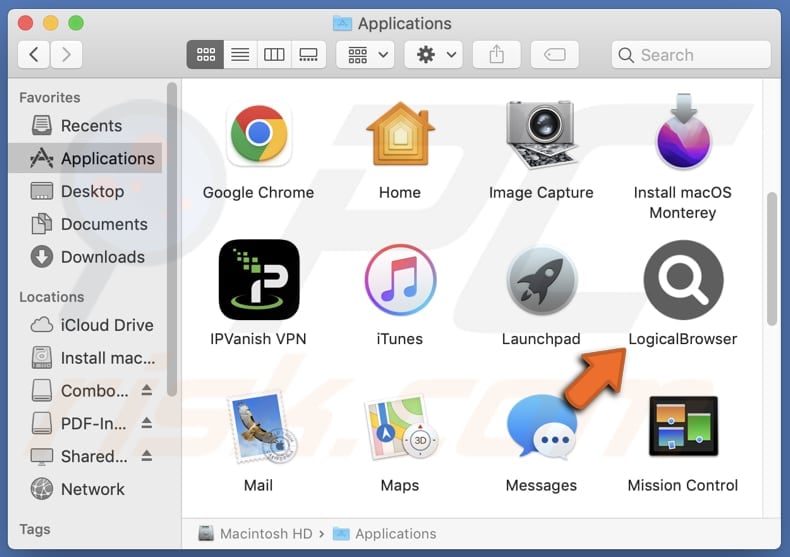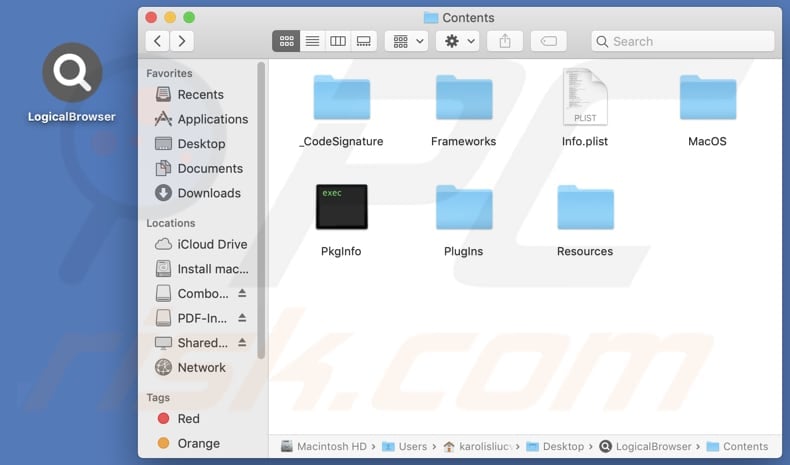How to remove LogicalBrowser unwanted app from computers
Mac VirusAlso Known As: Ads by LogicalBrowser
Get free scan and check if your device is infected.
Remove it nowTo use full-featured product, you have to purchase a license for Combo Cleaner. Seven days free trial available. Combo Cleaner is owned and operated by RCS LT, the parent company of PCRisk.com.
What is LogicalBrowser?
We have tested the LogicalBrowser application and discovered that it is created to serve intrusive advertisements to users. Apps of this type are classified as adware. Users often download and install software like LogicalBrowser unintentionally. It is recommended to avoid apps like LogicalBrowser and uninstall them if they are already present.

LogicalBrowser adware in detail
LogicalBrowser can display various advertisements, including banners, coupons, and pop-ups. These ads can contain unrealistic offers, fake warnings/alerts, and other misleading content to lure users into clicking them. Such interactions can lead users to potentially malicious websites or even unwanted downloads and installations.
Ads originating from LogicalBrowser may be used to promote fake giveaways, lotteries, investment opportunities, etc. Also. they may lead users to web pages hosting unwanted apps like browser hijackers or even malicious software. Furthermore, clicking ads displayed by LogicalBrowser might open phishing websites designed to steal credit card details, passwords, or other sensitive information.
LogicalBrowser may also deliver ads designed to promote technical support scams where users might be tricked into calling scammers and providing personal information, paying for fake (or unnecessary) services/products, downloading malware, or taking other actions. Therefore, ads displayed by LogicalBrowser or similar software cannot be trusted.
Beyond displaying ads, adware often collects user data, such as browsing habits and personal information, that can be misused in certain ways. Additionally, it can slow down devices, cause browser redirects, and lead to a degraded user experience. Overall, it is recommended not to install software like LogicalBrowser.
| Name | Ads by LogicalBrowser |
| Threat Type | Adware, Mac malware, Mac virus |
| Detection Names | Avast (MacOS:Adload-AG [Adw]), Combo Cleaner (Gen:Variant.Adware.MAC.AdLoad.13), ESET-NOD32 (A Variant Of OSX/Adware.Synataeb.H), Kaspersky (Not-a-virus:HEUR:AdWare.OSX.Adload.j), Full List (VirusTotal) |
| Additional Information | This application belongs to Adload malware family. |
| Symptoms | Your Mac becomes slower than normal, you see unwanted pop-up ads, you are redirected to dubious websites. |
| Distribution methods | Deceptive pop-up ads, free software installers (bundling), torrent file downloads. |
| Damage | Internet browser tracking (potential privacy issues), display of unwanted ads, redirects to dubious websites, loss of private information. |
| Malware Removal (Windows) |
To eliminate possible malware infections, scan your computer with legitimate antivirus software. Our security researchers recommend using Combo Cleaner. Download Combo CleanerTo use full-featured product, you have to purchase a license for Combo Cleaner. 7 days free trial available. Combo Cleaner is owned and operated by RCS LT, the parent company of PCRisk.com. |
Conclusion
In conclusion, while primarily aimed at generating annoying ads, adware can disrupt user experiences, compromise system performance, and compromise personal data security. Typically, software of this type is promoted using questionable methods to trick users into installing it. Users who suspect that they have adware installed on their computers should run a system scan using a reputable security tool.
More examples of adware-type software are DomainNameEdit, TaskSite, and Academization.app.
How did LogicalBrowser install on my computer?
Users may inadvertently install adware when installing other (usually free or shady) software. Adware can be included as an optional installation in software bundles, and users may inadvertently accept its installation if they do not deselect it using options like "Advanced" or "Custom" during the setup process.
Adware can also be accidentally installed via deceptive advertisements, third-party app stores, peer-to-peer networks, notifications from unreliable websites, fraudulent pop-up warnings (or similar content on shady sites), third-party downloaders, and similar channels.
How to avoid installation of unwanted applications?
Download software and apps only from official pages and trusted app stores. Avoid using peer-to-peer (P2P) networks and similar sources or downloading pirated software. Do not interact with advertisements, alerts, buttons, and other content on suspicious websites. Also, do not permit questionable websites to send notifications.
Additionally, ensure your operating system and software are regularly updated, and use reliable security software. If your computer is already infected with LogicalBrowser, we recommend running a scan with Combo Cleaner Antivirus for Windows to automatically eliminate this adware.
A pop-up message that appears after the installation of LogicalBrowser:

LogicalBrowser's installation folder:

Instant automatic malware removal:
Manual threat removal might be a lengthy and complicated process that requires advanced IT skills. Combo Cleaner is a professional automatic malware removal tool that is recommended to get rid of malware. Download it by clicking the button below:
DOWNLOAD Combo CleanerBy downloading any software listed on this website you agree to our Privacy Policy and Terms of Use. To use full-featured product, you have to purchase a license for Combo Cleaner. 7 days free trial available. Combo Cleaner is owned and operated by RCS LT, the parent company of PCRisk.com.
Quick menu:
- What is LogicalBrowser?
- STEP 1. Remove LogicalBrowser related files and folders from OSX.
- STEP 2. Remove LogicalBrowser ads from Safari.
- STEP 3. Remove LogicalBrowser adware from Google Chrome.
- STEP 4. Remove LogicalBrowser ads from Mozilla Firefox.
Video showing how to remove LogicalBrowser adware using Combo Cleaner:
LogicalBrowser adware removal:
Remove LogicalBrowser-related potentially unwanted applications from your "Applications" folder:

Click the Finder icon. In the Finder window, select "Applications". In the applications folder, look for "MPlayerX", "NicePlayer", or other suspicious applications and drag them to the Trash. After removing the potentially unwanted application(s) that cause online ads, scan your Mac for any remaining unwanted components.
DOWNLOAD remover for malware infections
Combo Cleaner checks if your computer is infected with malware. To use full-featured product, you have to purchase a license for Combo Cleaner. 7 days free trial available. Combo Cleaner is owned and operated by RCS LT, the parent company of PCRisk.com.
Remove adware-related files and folders

Click the Finder icon, from the menu bar. Choose Go, and click Go to Folder...
 Check for adware generated files in the /Library/LaunchAgents/ folder:
Check for adware generated files in the /Library/LaunchAgents/ folder:

In the Go to Folder... bar, type: /Library/LaunchAgents/

In the "LaunchAgents" folder, look for any recently-added suspicious files and move them to the Trash. Examples of files generated by adware - "installmac.AppRemoval.plist", "myppes.download.plist", "mykotlerino.ltvbit.plist", "kuklorest.update.plist", etc. Adware commonly installs several files with the exact same string.
 Check for adware generated files in the ~/Library/Application Support/ folder:
Check for adware generated files in the ~/Library/Application Support/ folder:

In the Go to Folder... bar, type: ~/Library/Application Support/

In the "Application Support" folder, look for any recently-added suspicious folders. For example, "MplayerX" or "NicePlayer", and move these folders to the Trash.
 Check for adware generated files in the ~/Library/LaunchAgents/ folder:
Check for adware generated files in the ~/Library/LaunchAgents/ folder:

In the Go to Folder... bar, type: ~/Library/LaunchAgents/

In the "LaunchAgents" folder, look for any recently-added suspicious files and move them to the Trash. Examples of files generated by adware - "installmac.AppRemoval.plist", "myppes.download.plist", "mykotlerino.ltvbit.plist", "kuklorest.update.plist", etc. Adware commonly installs several files with the exact same string.
 Check for adware generated files in the /Library/LaunchDaemons/ folder:
Check for adware generated files in the /Library/LaunchDaemons/ folder:

In the "Go to Folder..." bar, type: /Library/LaunchDaemons/

In the "LaunchDaemons" folder, look for recently-added suspicious files. For example "com.aoudad.net-preferences.plist", "com.myppes.net-preferences.plist", "com.kuklorest.net-preferences.plist", "com.avickUpd.plist", etc., and move them to the Trash.
 Scan your Mac with Combo Cleaner:
Scan your Mac with Combo Cleaner:
If you have followed all the steps correctly, your Mac should be clean of infections. To ensure your system is not infected, run a scan with Combo Cleaner Antivirus. Download it HERE. After downloading the file, double click combocleaner.dmg installer. In the opened window, drag and drop the Combo Cleaner icon on top of the Applications icon. Now open your launchpad and click on the Combo Cleaner icon. Wait until Combo Cleaner updates its virus definition database and click the "Start Combo Scan" button.

Combo Cleaner will scan your Mac for malware infections. If the antivirus scan displays "no threats found" - this means that you can continue with the removal guide; otherwise, it's recommended to remove any found infections before continuing.

After removing files and folders generated by the adware, continue to remove rogue extensions from your Internet browsers.
Remove malicious extensions from Internet browsers
 Remove malicious Safari extensions:
Remove malicious Safari extensions:

Open the Safari browser, from the menu bar, select "Safari" and click "Preferences...".

In the preferences window, select "Extensions" and look for any recently-installed suspicious extensions. When located, click the "Uninstall" button next to it/them. Note that you can safely uninstall all extensions from your Safari browser - none are crucial for regular browser operation.
- If you continue to have problems with browser redirects and unwanted advertisements - Reset Safari.
 Remove malicious extensions from Google Chrome:
Remove malicious extensions from Google Chrome:

Click the Chrome menu icon ![]() (at the top right corner of Google Chrome), select "More Tools" and click "Extensions". Locate all recently-installed suspicious extensions, select these entries and click "Remove".
(at the top right corner of Google Chrome), select "More Tools" and click "Extensions". Locate all recently-installed suspicious extensions, select these entries and click "Remove".

- If you continue to have problems with browser redirects and unwanted advertisements - Reset Google Chrome.
 Remove malicious extensions from Mozilla Firefox:
Remove malicious extensions from Mozilla Firefox:

Click the Firefox menu ![]() (at the top right corner of the main window) and select "Add-ons and themes". Click "Extensions", in the opened window locate all recently-installed suspicious extensions, click on the three dots and then click "Remove".
(at the top right corner of the main window) and select "Add-ons and themes". Click "Extensions", in the opened window locate all recently-installed suspicious extensions, click on the three dots and then click "Remove".

- If you continue to have problems with browser redirects and unwanted advertisements - Reset Mozilla Firefox.
Frequently Asked Questions (FAQ)
What harm can adware cause?
Adware can cause multiple issues, including intrusive advertisements that disrupt user experience, slow down device performance, and compromise privacy by collecting user data without consent.
What does adware do?
Adware bombards users with intrusive advertisements. Also, it can be designed to hijack browsers and harvest various information.
How do adware developers generate revenue?
They often participate in affiliate marketing programs where they earn commissions for driving traffic to specific products, services, or websites through the ads displayed by their adware.
Will Combo Cleaner remove LogicalBrowser adware?
Combo Cleaner will scan your computer and remove all installed adware-type applications. However, manual removal may not be effective, as it can leave behind residual files that may remain active even after the adware is deleted.
Share:

Tomas Meskauskas
Expert security researcher, professional malware analyst
I am passionate about computer security and technology. I have an experience of over 10 years working in various companies related to computer technical issue solving and Internet security. I have been working as an author and editor for pcrisk.com since 2010. Follow me on Twitter and LinkedIn to stay informed about the latest online security threats.
PCrisk security portal is brought by a company RCS LT.
Joined forces of security researchers help educate computer users about the latest online security threats. More information about the company RCS LT.
Our malware removal guides are free. However, if you want to support us you can send us a donation.
DonatePCrisk security portal is brought by a company RCS LT.
Joined forces of security researchers help educate computer users about the latest online security threats. More information about the company RCS LT.
Our malware removal guides are free. However, if you want to support us you can send us a donation.
Donate
▼ Show Discussion